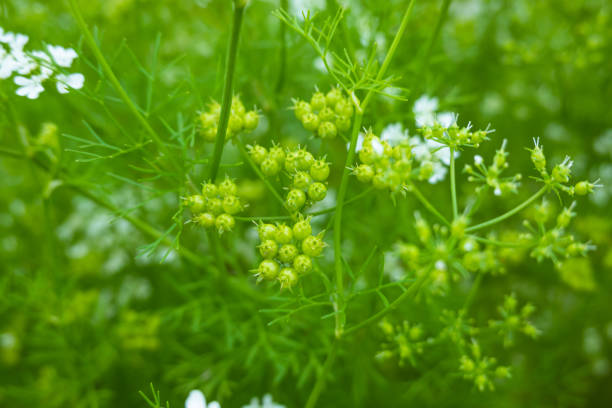Caraway (Carum carvi) ‘Biennial’
£0.99 – £2.85
Caraway (Carum carvi)
Caraway seeds should be sown in late spring or early summer when the soil has warmed up to 15-20°C (60-70°F). They can also be sown directly in the ground in autumn for an early summer harvest the following year. Choose a sunny spot with well-draining, fertile soil that is not too acidic or alkaline. Caraway plants prefer a pH range of 6.0-7.5. If planting in a pot, use a good quality, well-draining potting mix.
Sow caraway seeds about 1 cm deep in rows 30 cm (12 inches) apart. Water the seeds well after planting and keep the soil consistently moist without making it waterlogged. Caraway seeds can take anywhere from 14 to 30 days to germinate. Thin them once they reach about 5 cm (2 inches) in height and give each plant enough space to grow.
Keep the area weed-free by regularly hoeing around the plants. A light feed with a balanced organic fertilizer in the spring can help promote growth. Pinch out the tips of the caraway plants when they reach about 20 cm (8 inches) tall to encourage bushier growth and more leaves for harvest.
The caraway plant, related to the carrot and parsley family, is a cool-season herb native to Europe and Asia. It is widely cultivated worldwide for its aromatic seeds, which are used in various dishes and medicinal purposes. The plant grows up to 2 feet tall with feathery leaves similar to carrots and small, white or pink flowers that bloom in umbels in the summer. Caraway seeds are the most commonly used part of the plant, with a distinctive pungent aroma and warm, slightly sweet flavour.
Caraway seeds are used as a spice in various dishes, particularly in European and Middle Eastern cuisines. They are also used in breads, cakes, biscuits, stews, soups, and pickles, adding a unique flavour. Caraway seeds have traditionally been used for their carminative properties, helping to expel gas from the digestive tract and relieving flatulence. They are also used to treat digestive issues like indigestion and colic.
The essential oil extracted from caraway seeds is used in the production of liquors, perfumes, and soaps due to its pleasant scent.
Caraway plants are relatively low maintenance and not typically prone to pests or diseases. They can be planted with other members of the Apiaceae family, such as dill, parsley, coriander, onions, and cabbages. Seeds are ready to harvest when they turn brown and have a strong aroma, typically around 4-5 months after planting. Caraway seeds should be stored in a cool, dark place in airtight containers to maintain their flavour.
